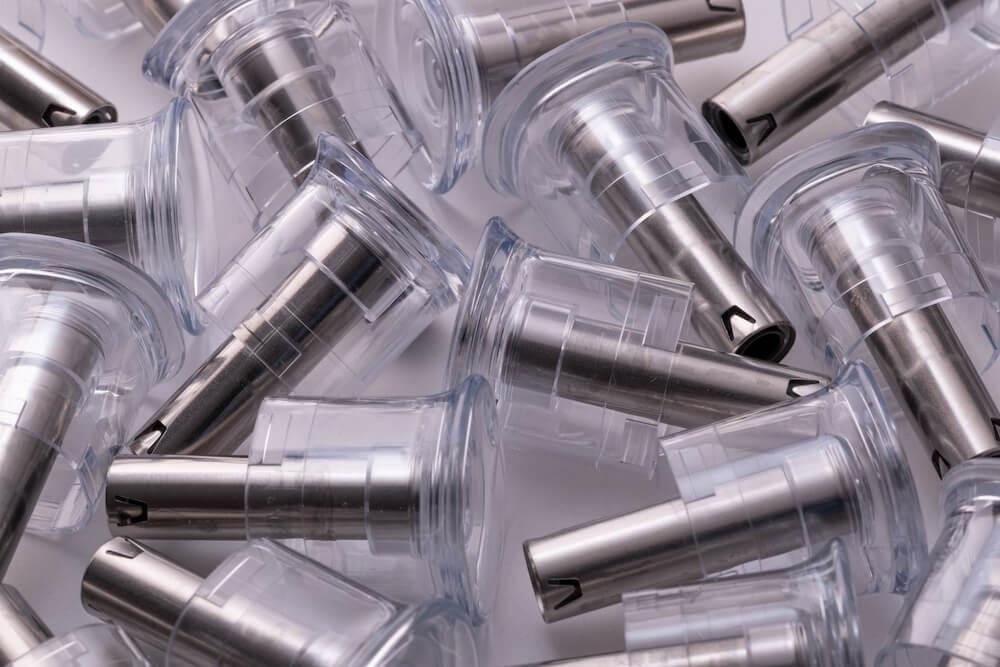Overmolding is a specialized manufacturing process that involves molding one material over another to create a single part. This technique often adds soft-touch surfaces on hard plastics, combines different materials for aesthetic appeal, or encapsulates metal components.
Overmolding is used widely across various industries, including consumer electronics, automotive, medical devices, and more, enabling the creation of products that are not only functional but also ergonomic and visually appealing. By combining different materials, manufacturers can design products that meet specific performance criteria, enhance user experience, and comply with safety standards. For instance, overmolding can create a soft, rubber-like grip on a power tool, making it more comfortable and safer to use, or encapsulate a metal fastener in a plastic housing to make the connectors more robust.
However, overmolding presents unique challenges that must be carefully managed to ensure a project’s success. These challenges span from material selection to the intricacies of mold design and process optimization, each playing a crucial role in achieving high-quality overmolded parts.
Understanding Overmolding
Overmolding is a two-step injection molding process in which two or more materials are molded together to form a single component. It can also be defined as insert molding or multiple-shot molding.
Insert molding involves manually placing the part overmolded into the mold cavity, closing the mold, and injecting plastic into the cavity. This technique includes metal features within plastic parts, such as threaded bosses or needles, or creates a plastic part of multiple materials.
Multiple-shot molding is a technique that requires specialized injection molding presses. In this technique, both materials are injection molded during a single molding process. It is typically used in high-volume production scenarios.
The materials commonly used in overmolding include various types of plastics, elastomers, and sometimes metals, with thermoplastic elastomers (TPEs) being a popular choice for the overmold material due to their flexibility and bonding capabilities with other plastics.
Common Applications in Various Industries
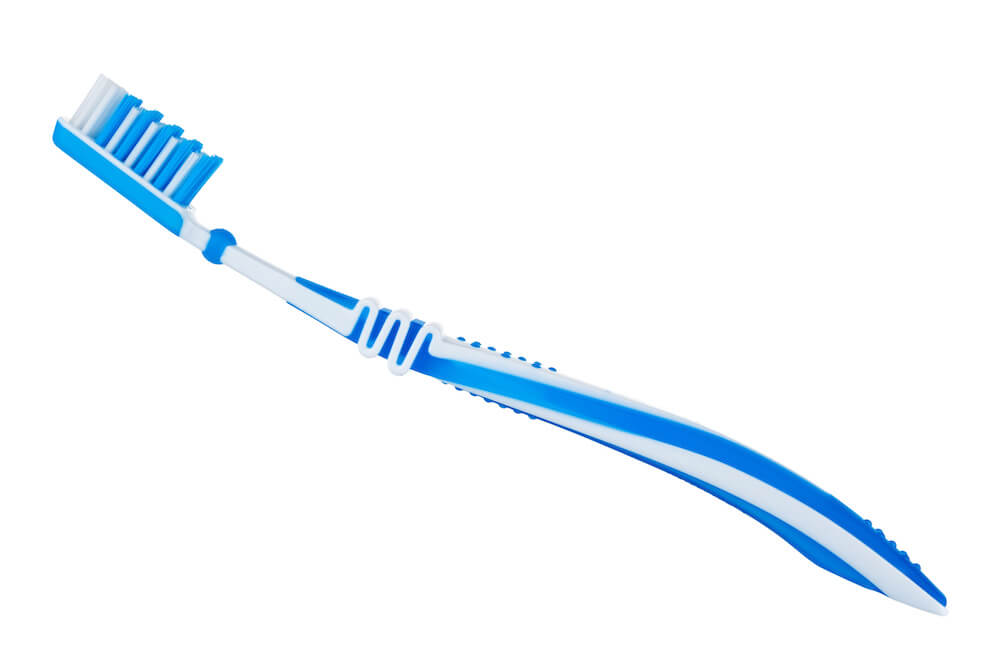
- Consumer Products: Overmolding creates ergonomic, durable, and aesthetically pleasing components such as smartphone cases, earbud grips, and power tool handles. It provides a soft grip for handheld devices and contributes to the overall user experience.
- Automotive: In the automotive industry, overmolding is applied in manufacturing components like gear knobs, door handles, and steering wheel grips. These applications benefit from overmolding by combining strength with a comfortable touch and improved aesthetics.
- Medical Devices: Overmolding is critical in creating medical devices that are ergonomic, easy to clean, and safe to use. Examples include surgical instruments with non-slip grips, fluidic devices that require elastomeric seals, and medical equipment encasements that are comfortable to hold and resistant to fluids.
- Sports and Recreation: Sporting goods, such as bicycle handles, fishing rods, and protective gear, utilize overmolding for enhanced durability, comfort, and shock absorption.
- Industrial Tools and Equipment: Overmolding provides additional insulation, vibration damping, and slip resistance in industrial tools and equipment handles, improving safety and usability.
Benefits of Overmolding in Product Design and Functionality
- Enhanced Aesthetics: Overmolding allows for integrating different colors and textures in a single component, improving the product’s visual appeal and brand differentiation.
- Improved Ergonomics: The process can create parts with soft-touch surfaces that are more comfortable to hold and use, reducing user fatigue and increasing satisfaction.
- Increased Durability and Protection: Overmolded components often exhibit increased strength and resistance to impact, wear, and environmental factors. This protection is particularly beneficial for products exposed to harsh conditions or frequent use.
- Better Product Performance: Overmolding can enhance a product’s overall performance by combining materials with different properties. For example, adding a rubber-like material to a rigid component can provide better grip and shock absorption.
- Cost Efficiency: Overmolding can reduce assembly costs by integrating multiple functions and components into a single molded part, eliminating the need for additional assembly or fastening processes.
Overmolding is a versatile manufacturing process that offers significant product design and functionality benefits. Its ability to combine different materials into a cohesive component enables designers and engineers to create functional, durable, user-friendly, and aesthetically pleasing products. The widespread applications of overmolding across various industries underscore its importance in modern manufacturing and product development.
Prototyping plays a crucial role in evaluating the overmolded component, especially when the overmold is a functional design aspect. It allows designers and engineers to evaluate designs and experiment with different materials and molding techniques before moving to full-scale production.
Challenges in Overmold Prototyping
Overmolding presents a unique set of challenges for designers and manufacturers. Prototyping overmolded components help identify and solve potential overmolding issues, such as material compatibility, improper bonding, or mold or part design issues.
Material Compatibility
Selecting the right material pair involves understanding their bonding mechanisms, such as mechanical interlocking or chemical bonding, and requires thorough testing during the prototyping phase to validate compatibility.
When overmolding a plastic component, substrate, and overmold materials must be chosen with consideration for their chemical and physical properties to ensure they bond well during the overmolding process. Thermal compatibility must also be considered, as materials with significantly different melting temperatures can pose challenges during molding. Incompatible materials can lead to weak interfaces, delamination, or failure under stress, affecting the part’s durability and performance. In cases where materials are incompatible or when the overmolding incorporates a metal component, mechanical encapsulation must be designed into the part by incorporating undercuts or holes in the substrate.
Mold Design Complexity
Designing molds for overmolding increases mold complexity beyond that of standard injection molding. Key considerations include capturing the substrate to prevent movement during injection of the overmold material, placing gates and runners to optimize material flow, seamlessly routing the overmold to the desired location, designing vents to prevent air traps, and determining the mechanism for part ejection without damaging the overmolded component.
The mold design must also account for the shrinkage and expansion of different materials to avoid warping or defects. These complexities necessitate advanced mold design expertise and often sophisticated simulation tools to predict and resolve potential issues before mold fabrication.
Process Parameters Optimization
Achieving quality overmolding results requires precise optimization of injection molding parameters, including temperature, pressure, and speed. These parameters must be tailored to the specific material combination and part design to ensure complete filling, proper bonding, and minimal defects. Variations in temperature or pressure can lead to poor material flow, incomplete bonding, or blemishes such as sink marks and voids. Optimizing these parameters is a trial-and-error process that can be time-consuming and requires extensive prototyping to identify the ideal settings for each unique overmolding project.
Prototyping Costs
The costs associated with overmold prototyping by injection molding depend on the part’s complexity and mold design. At a minimum, overmolding requires an additional cavity to be machined, increasing the injection mold cost. Additional cycle time is needed during molding to manually place the substrate or metal insert into the mold cavity before overmolding, and in the case where a plastic substrate is overmolded, the cost must include two separate molding cycles. Additional part processing time can be required to troubleshoot part capture, test material compatibility, and fine-tune process parameters.
The use of specialized materials and the potential for increased scrap rates during testing further elevate expenses. Managing these costs while still achieving the desired outcome requires careful planning, efficient design iteration, and, where possible, simulation to minimize the need for physical prototypes.
Lead Times
Overmolding can extend prototyping timelines due to the complexities involved in mold design, material selection, and process optimization. Each iteration of the prototype can introduce delays, especially if issues arise that require mold modifications or material changes. Strategies to mitigate these challenges include the early involvement of experienced engineers and mold designers and selecting a prototyping partner that is capable of making rapid mold changes. However, solving these issues at the prototyping stage is preferable to working them out on production tools when project delays are more costly.
Navigating the challenges of overmold prototyping requires a comprehensive understanding of materials science, mold design, and injection molding processes. Success in this area hinges on meticulous planning, expert execution, and the flexibility to adapt to findings during the prototyping phase. By effectively addressing these challenges, manufacturers can leverage the benefits of overmolding to create innovative, functional, and aesthetically pleasing products.
Case Studies
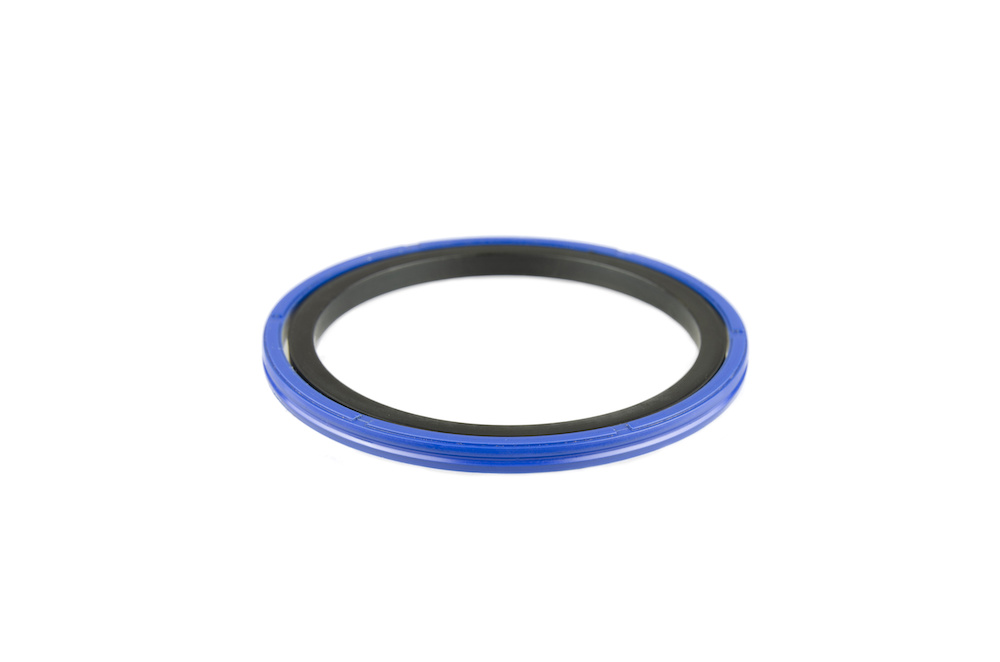
A customer developed prototype parts that were intended to be assembled with an internal o-ring to create a seal between mating parts. Accurate and repeatable assembly of the o-ring was not a trivial task. Also, during shipping tests, the o-rings sometimes became dislodged, causing assembly and sealing issues with the mating part during use. The part was modified slightly to accommodate the injection of an overmolded TPE (Thermoplastic Elastomer, i.e, synthetic rubber) on the interior surface of the part to replace the o-ring. Overmold-compatible substrate and elastomer materials were selected to ensure the TPE adhered to the substrate to prevent leak paths. The addition of the overmold solved the shipping issues, and the challenging assembly step to insert the o-ring was eliminated.
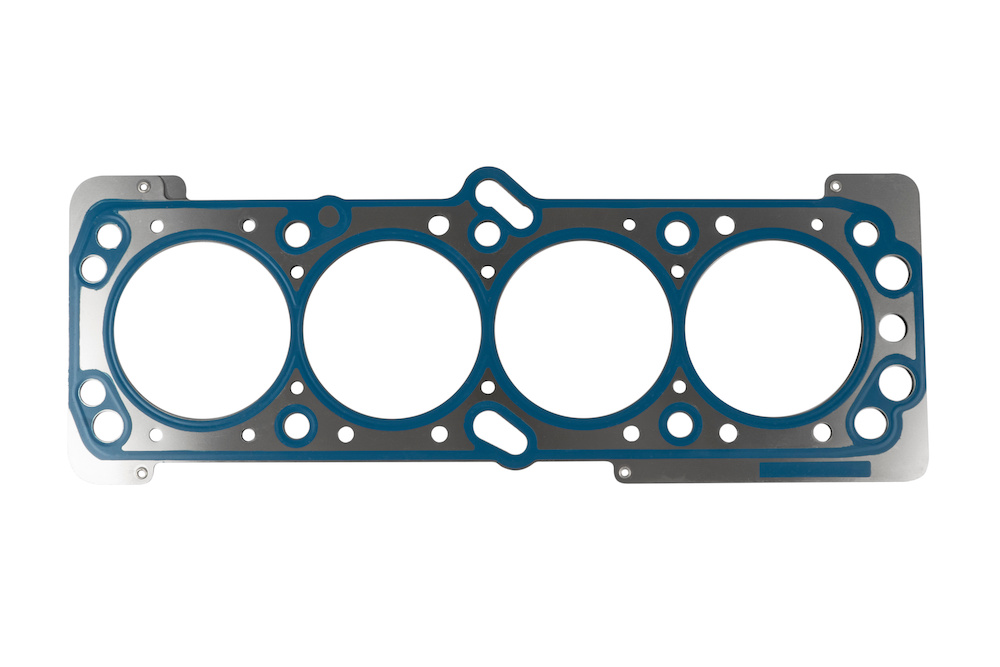
An IVD (In Vitro Diagnostic) cartridge was leaking at a gasket interface with the instrument that ran the on-cartridge assay using pneumatic pressures. The gasket consisted of a silicone sheet backed with double-sided adhesive. Leaks at the interface rendered the diagnostic test useless; results were not consistent because pressures driving the assay were inconsistent. To eliminate the leak, the gasket was instead overmolded directly onto the test cartridge. This rendered the assay results more reliable and eliminated an assembly and QC step in manufacturing.
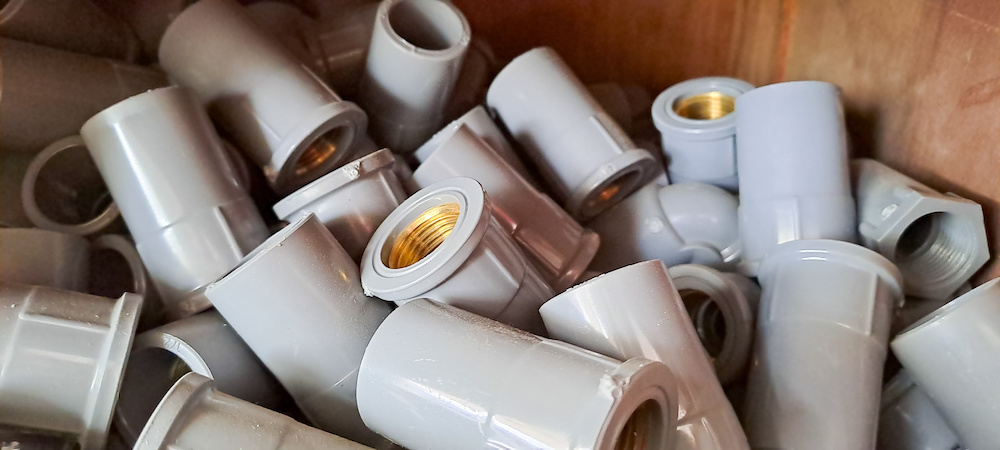
A plastic housing was created that assembled mating components with thread forming screws for plastic. These screws, when assembled, slice through plastic with minimal stress and low torque. However, the plastic threads that are created can easily become stripped. In a case where the screw threads were under physical and thermal load, metal fasteners provided a more robust solution. These threaded fasteners were inserted into the mold and the plastic housing molded around them, creating stronger, more reliable assembly features.
Best Practices for Overmolding Prototyping
Overmold prototyping allows for the creation of complex, multi-material components with enhanced functionality, aesthetics, and ergonomics. To ensure the success of overmolding projects, best practices include careful material selection, thoughtful mold design, experienced process optimization, and collaboration with experienced manufacturing partners:
Material Selection
- Comprehensive Compatibility Testing: Conduct thorough compatibility tests between substrate and overmold materials to ensure strong bonding and functionality. This includes evaluating chemical compatibility, mechanical bonding, and thermal resistance.
- Consider End-use Requirements: Select materials based on the final product’s operational environment, including temperature exposure, chemical resistance, and mechanical stress.
- Use of Material Databases: Leverage extensive material databases and supplier expertise to identify materials with proven success in overmolding applications.
Mold Design
- Incorporate Simulation: Utilize mold flow analysis and simulation software from the early stages of mold design to predict and mitigate potential issues related to material flow, air entrapment, and thermal balance.
- Design for Manufacturability (DFM): Apply DFM principles to simplify the mold design, ensuring it supports efficient material use, reduces cycle times, and minimizes the risk of defects.
- Modular and Reusable Molds: Where possible, design molds to be modular and adaptable for various projects to reduce costs and lead times.
Process Optimization
- Trial Runs and Prototyping: Perform small-scale trial runs to fine-tune injection molding parameters, including temperature, pressure, and injection speed, optimizing for quality and efficiency.
Collaboration with Manufacturing Partners
- Select Experienced Partners: Work with prototyping or manufacturing partners with extensive overmolding experience and can provide valuable insights into the material selection, mold design, and process optimization.
- Early Engagement: Involve your manufacturing partners early in the design process to benefit from their expertise in making design choices that facilitate easier, faster, and more cost-effective production.
- Open Communication and Feedback Loops: Establish open lines of communication and regular feedback loops with your partners to swiftly address challenges, make necessary adjustments, and share knowledge and insights throughout the prototyping phase.
Additional Considerations
- Regulatory Compliance: Ensure that materials and processes comply with relevant industry regulations and standards, especially in sectors like medical devices, automotive, and consumer electronics.
Following these best practices in overmold prototyping enhances the likelihood of project success and contributes to developing innovative, high-quality products that meet or exceed customer expectations. Having well-chosen materials, expertly designed molds, optimized processes, and collaborative partnerships are crucial to navigating the complexities of overmolding projects efficiently and effectively.
Solutions to Prototype Overmolding with Protoshop, Inc.
Overmolding enhances product functionality, aesthetics, and ergonomics and presents unique challenges in material compatibility, mold design, process optimization, and cost management.
At Protoshop Inc., we understand the intricacies of overmold prototyping and are equipped with the expertise, technology, and strategies needed to guide your project from concept to completion. By leveraging our knowledge of advanced materials, sophisticated mold design techniques, and optimized processing parameters, we help our clients overcome the hurdles associated with overmolding to achieve exceptional product quality and performance.
We encourage you to approach your overmold prototyping projects strategically, utilizing the best practices discussed, such as thorough material selection, simulation-driven mold design, process fine-tuning, and cost-effective production techniques. Collaborating with an experienced prototyping partner like Protoshop Inc. ensures you have the support and insights to navigate these challenges effectively.
Contact Protoshop Inc. today to learn how we can support your overmold prototyping and production needs, ensuring your projects are executed flawlessly, on time, and within budget.


